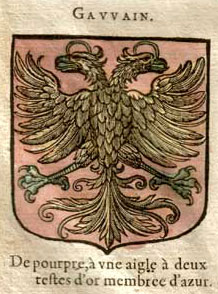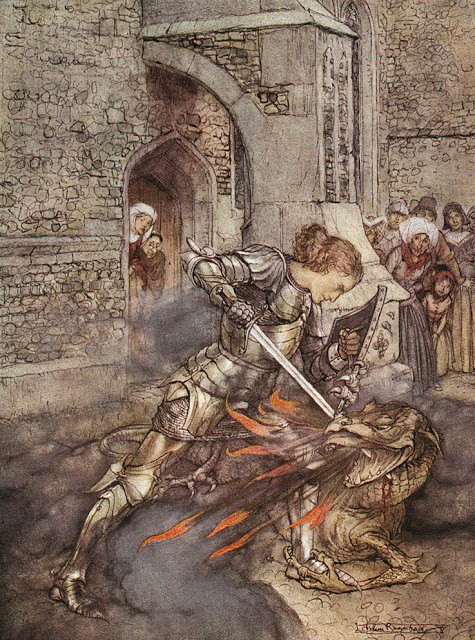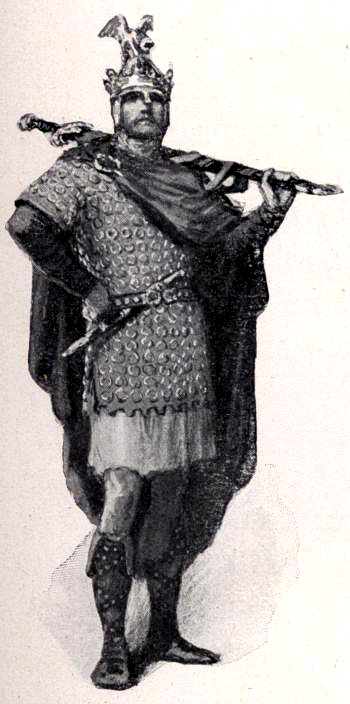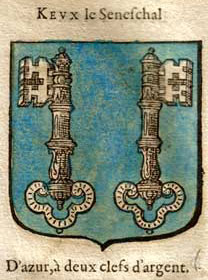|
Perlesvaus
''Perlesvaus'', also called ''Li Hauz Livres du Graal'' (''The High Book of the Grail''), is an Old French Arthurian romance dating to the first decade of the 13th century. It purports to be a continuation of Chrétien de Troyes' unfinished ''Perceval, the Story of the Grail'', but it has been called the least canonical Arthurian tale because of its striking differences from other versions. Synopsis ''Perlesvaus'', which presents itself as be a translation of a Latin source found in Avalon as narrated by Josephus, follows a high complex narrative chronicling the progress of various Knights of the Round Table in their quest for the Holy Grail. It begins by explaining that its main character, Percival, did not fulfill his destiny of achieving the Grail because he failed to ask the Fisher King the question that would heal him, events related in Chrétien's work. The author soon digresses into the adventures of knights like Lancelot and Gawain, many of which have no analogue in othe ... [...More Info...] [...Related Items...] OR: [Wikipedia] [Google] [Baidu] |
Knights Of The Round Table
The Knights of the Round Table ( cy, Marchogion y Ford Gron, kw, Marghekyon an Moos Krenn, br, Marc'hegien an Daol Grenn) are the knights of the fellowship of King Arthur in the literary cycle of the Matter of Britain. First appearing in literature in the mid-12th century, the Knights are an order dedicated to ensuring the peace of Arthur's kingdom following an early warring period, entrusted in later years to undergo a mystical quest for the Holy Grail. The Round Table at which they meet is a symbol of the equality of its members, who range from sovereign royals to minor nobles. The various stories in the cycle present an assortment of knights from all over Great Britain and abroad, some of whom are even from outside of Europe. Their ranks often include Arthur's close and distant relatives, such as Agravain and Gaheris, as well as his reconciled enemies and those he defeated in battle, including Galehaut and Lot. Several of the most notable knights, including Bediver ... [...More Info...] [...Related Items...] OR: [Wikipedia] [Google] [Baidu] |
Perceval, The Story Of The Grail
''Perceval, the Story of the Grail'' (french: Perceval ou le Conte du Graal) is the unfinished fifth verse romance by Chrétien de Troyes, written by him in Old French in the late 12th century. Later authors added 54,000 more lines in what are known collectively as the Four Continuations,Grigsby, John L. (1991). "Continuations of ''Perceval''". In Norris J. Lacy, ''The New Arthurian Encyclopedia'', pp. 99–100. New York: Garland. . as well as other related texts. ''Perceval'' is the earliest recorded account of what was to become the Quest for the Holy Grail but describes only a golden grail (a serving dish) in the central scene, does not call it "holy" and treats a lance, appearing at the same time, as equally significant. ''Perceval'' ''Perceval'' is dedicated to Chrétien's patron Philip I, Count of Flanders.Lacy, Norris J. (1991). "Chrétien de Troyes". In Norris J. Lacy, ''The New Arthurian Encyclopedia'', pp. 88–91. New York: Garland. . It was written in Old French ... [...More Info...] [...Related Items...] OR: [Wikipedia] [Google] [Baidu] |
Guinevere
Guinevere ( ; cy, Gwenhwyfar ; br, Gwenivar, kw, Gwynnever), also often written in Modern English as Guenevere or Guenever, was, according to Arthurian legend, an early-medieval queen of Great Britain and the wife of King Arthur. First mentioned in popular literature in the early 12th century, nearly 700 years after the purported times of Arthur, Guinevere has since been portrayed as everything from a villainous and opportunistic traitor to a fatally flawed but noble and virtuous lady. Many records of the legend also feature the variably recounted story of her abduction and rescue as a major part of the tale. The earliest datable appearance of Guinevere is in Geoffrey of Monmouth's pseudo-historical British chronicle '' Historia Regum Britanniae'', in which she is seduced by Mordred during his ill-fated rebellion against Arthur. In a later medieval Arthurian romance tradition from France, a prominent story arc is the queen's tragic love affair with her husband's chief k ... [...More Info...] [...Related Items...] OR: [Wikipedia] [Google] [Baidu] |
Gawain
Gawain (), also known in many other forms and spellings, is a character in Arthurian legend, in which he is King Arthur's nephew and a Knight of the Round Table. The prototype of Gawain is mentioned under the name Gwalchmei in the earliest Welsh sources. He has subsequently appeared in many Arthurian stories in Welsh, Latin, French, English, Scottish, Dutch, German, Spanish, and Italian, notably as the protagonist of the famous Middle English poem '' Sir Gawain and the Green Knight''. Other tales featuring Gawain as the central character include '' De Ortu Waluuanii'', '' Diu Crône'', '' Ywain and Gawain'', '' Golagros and Gawane'', '' Sir Gawain and the Carle of Carlisle'', '' L'âtre périlleux'', '' La Mule sans frein'', '' La Vengeance Raguidel'', '' Le Chevalier à l'épée'', '' The Awntyrs off Arthure'', '' The Greene Knight'', and '' The Weddynge of Syr Gawen and Dame Ragnell''. In Arthurian chivalric romance literature, Gawain is usually depicted as King Arthur's ... [...More Info...] [...Related Items...] OR: [Wikipedia] [Google] [Baidu] |
Fisher King
The Fisher King is a figure in Arthurian legend, the last in a long line of British kings tasked with guarding the Holy Grail. The Fisher King is both the protector and physical embodiment of his lands, but a wound renders him incapable and his kingdom barren. Unable to walk or ride a horse, he is sometimes depicted as spending his time fishing while he awaits a "chosen one" who can heal him. Versions of the story vary widely, but the Fisher King is typically depicted as being wounded in the groin, legs or thigh, rendering him infertile. The healing of these wounds always depends upon the completion of a hero-knight's task. Most versions of the story contain the Holy Grail and the Lance of Longinus as plot elements. In some versions, a third character is introduced. This individual, unlike the hero-knight archetype, is ignorant of the King's power, but has the ability to save the king and land, or to doom it. Variations of this third party give us divergent legends. As a lite ... [...More Info...] [...Related Items...] OR: [Wikipedia] [Google] [Baidu] |
Lancelot
Lancelot du Lac (French for Lancelot of the Lake), also written as Launcelot and other variants (such as early German ''Lanzelet'', early French ''Lanselos'', early Welsh ''Lanslod Lak'', Italian ''Lancillotto'', Spanish ''Lanzarote del Lago'', and Welsh ''Lawnslot y Llyn''), is a character in some versions of Arthurian legend, where he is typically depicted as King Arthur's close companion and one of the greatest Knights of the Round Table. In the French-inspired Arthurian chivalric romance tradition, Lancelot is an orphaned son of King Ban of the lost Kingdom of Benoic, raised in the fairy realm by the Lady of the Lake. A hero of many battles, quests and tournaments, and famed as a nearly unrivalled swordsman and jouster, Lancelot becomes the lord of the castle Joyous Gard and personal champion of Arthur's wife, Queen Guinevere, despite suffering from frequent and sometimes prolonged fits of madness. But when his adulterous affair with Guinevere is discovered, it ca ... [...More Info...] [...Related Items...] OR: [Wikipedia] [Google] [Baidu] |
Percival
Percival (, also spelled Perceval, Parzival), alternatively called Peredur (), was one of King Arthur's legendary Knights of the Round Table. First mentioned by the French author Chrétien de Troyes in the tale ''Perceval, the Story of the Grail'', he is best known for being the original hero in the quest for the Grail, before being replaced in later English and French literature by Galahad. Etymology and origin The earliest reference to Perceval is in Chrétien de Troyes's first Arthurian romance ''Erec et Enide'', where, as "Percevaus li Galois" (Percevaus of Wales), he appears in a list of Arthur's knights; in another of Chrétien's romances, '' Cligés'', he is a "renowned vassal" who is defeated by the knight Cligés in a tournament. He then becomes the protagonist in Chrétien's final romance, ''Perceval, the Story of the Grail''. In the Welsh romance ''Peredur son of Efrawg'', the figure goes by the name Peredur. The name "Peredur" may derive from Welsh ''par'' (spea ... [...More Info...] [...Related Items...] OR: [Wikipedia] [Google] [Baidu] |
Fouke Fitz Warin
Fulk FitzWarin (1160x1180 – c. 1258), variant spellings ( Latinized ''Fulco filius Garini'', Welsh ''Syr ffwg ap Gwarin''), the third (Fulk III), was a prominent representative of a marcher family associated especially with estates in Shropshire (on the English border with Wales) and at Alveston in Gloucestershire. In young life (c. 1200–1203), early in the reign of King John (1199–1216), he won notoriety as the outlawed leader of a roving force striving to recover his familial right to Whittington Castle in Shropshire, which John had granted away to a Welsh claimant. Progressively rehabilitated, and enjoying his lordship, he endured further setbacks in 1215–1217. Thereafter, his connections with the court of Llywelyn ap Iorwerth and his usefulness to the English king placed him in the midst of a larger conflict in which he lost Whittington to Llywelyn for a year in 1223–1224, though that prince was said to have married his daughter. During the 1220s Fulk founded A ... [...More Info...] [...Related Items...] OR: [Wikipedia] [Google] [Baidu] |
Arthurian Legend
The Matter of Britain is the body of medieval literature and legendary material associated with Great Britain and Brittany and the legendary kings and heroes associated with it, particularly King Arthur. It was one of the three great Western story cycles recalled repeatedly in medieval literature, together with the Matter of France, which concerned the legends of Charlemagne, and the Matter of Rome, which included material derived from or inspired by classical mythology. History The three "Matters" were first described in the 12th century by French poet Jean Bodel, whose epic ' ("Song of the Saxons") contains the line: The name distinguishes and relates the Matter of Britain from the mythological themes taken from classical antiquity, the " Matter of Rome", and the tales of the Paladins of Charlemagne and their wars with the Moors and Saracens, which constituted the " Matter of France". King Arthur is the chief subject of the Matter of Britain, along with stories ... [...More Info...] [...Related Items...] OR: [Wikipedia] [Google] [Baidu] |
King Arthur's Family
King Arthur's family grew throughout the centuries with King Arthur's legend. Many of the legendary members of this mythical king's family became leading characters of mythical tales in their own right. Medieval Welsh tradition In Welsh Arthurian pre-Galfridian tradition, meaning from before the time of Geoffrey of Monmouth's 12th-century ''Historia Regum Britanniae'' (''History of the Kings of Britain''), Arthur was granted numerous relations and family members. Several early Welsh sources are usually taken as indicative of Uther Pendragon being known as Arthur's father before Geoffrey wrote, with Arthur also being granted a brother (Madoc ap Uthyr, Madog) and a nephew (Eliwlod) in these texts. Arthur also appears to have been assigned a sister in this material – Gawain, Gwalchmei is named as his sister-son (nephew) in ''Culhwch and Olwen'', his mother being one Gwyar. ''Culhwch and Olwen'', the ''Vita Iltuti'' and the ''Brut Dingestow'' combine to suggest that Arthur's own ... [...More Info...] [...Related Items...] OR: [Wikipedia] [Google] [Baidu] |
Sir Kay
In Arthurian legend, Sir Kay ( cy, Cai, Middle Welsh ''Kei'' or ''Cei''; la, Caius; French: ''Keu''; Old French: ''Kès'' or ''Kex'') is King Arthur's foster brother and later seneschal, as well as one of the first Knights of the Round Table. In later literature he is known for his acid tongue and bullying, boorish behaviour, but in earlier accounts he was one of Arthur's premier warriors. Along with Bedivere, with whom he is frequently associated, Kay is one of the earliest characters associated with Arthur. Kay's father is called Ector in later literature, but the Welsh accounts name him as Cynyr Ceinfarfog. Cai in Welsh tradition Cai or Cei is one of the earliest characters to be associated with the Arthurian mythology, appearing in a number of early Welsh texts, including ''Culhwch ac Olwen'', '' Geraint fab Erbin'', '' Iarlles y Ffynnon'', '' Peredur fab Efrawg'', '' Breuddwyd Rhonabwy'', '' Pa Gur'', and the Welsh Triads. His father is given as Cynyr Ceinfarfog (For ... [...More Info...] [...Related Items...] OR: [Wikipedia] [Google] [Baidu] |
Holy Grail
The Holy Grail (french: Saint Graal, br, Graal Santel, cy, Greal Sanctaidd, kw, Gral) is a treasure that serves as an important motif in Arthurian literature. Various traditions describe the Holy Grail as a cup, dish, or stone with miraculous healing powers, sometimes providing eternal youth or sustenance in infinite abundance, often guarded in the custody of the Fisher King and located in the hidden Grail castle. By analogy, any elusive object or goal of great significance may be perceived as a "holy grail" by those seeking such. A "grail" (Old French: ''graal'' or ''greal''), wondrous but not unequivocally holy, first appears in '' Perceval, the Story of the Grail'', an unfinished chivalric romance written by Chrétien de Troyes around 1190. Chrétien's story inspired many continuations, translators and interpreters in the later-12th and early-13th centuries, including Wolfram von Eschenbach, who perceived the Grail as a stone. The Christian, Celtic or possibly other o ... [...More Info...] [...Related Items...] OR: [Wikipedia] [Google] [Baidu] |

.jpg)







